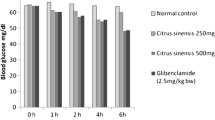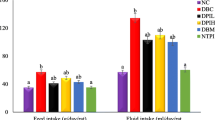Abstract
The purpose of this study was to investigate the effects of purple-fleshed potatoes on blood glucose level (BGL), insulin and lipid levels in streptozotocin (STZ) induced diabetic rats for 7 weeks. Test groups were divided into non-diabetic control and diabetic groups. The diabetic groups were further divided into three groups: diabetes mellitus (DM) control, 10% purple-fleshed potato DM (10PP-DM), and 20% purple-fleshed potato DM (20PPDM) groups. Three weeks after initiating the experimental diet, BGL was significantly lower in the 10PP-DM and 20PP-DM groups compared to the DM control group. As for serum insulin levels, the 20PP-DM group was significantly higher than in the DM control group. While serum cholesterol level was significantly lower in the 20PP-DM group, serum triglyceride level was significantly lower in the 10PP-DM group than in the DM control group. We concluded that a 20PP powder intake improves both diabetes and lipid control in diabetic rats by significantly improving serum insulin level and lowering BGL and serum cholesterol level.
Similar content being viewed by others
References
Park YE, Cho JH, Cho HM, Yi JY, Seo HW, Chung MG. A new potato cultivar “Hongyoung”, with red skin and flesh color, and high concentrations of anthocyanins. Korean J. Breed Sci. 41: 502–506 (2009)
Rural Development Administration. Food composition tables. Rural Development Administration, Korea 7: 66–68 (2006)
Brown CR. Antioxidants in potato. Am. J. Potato Res. 82: 163–172 (2005)
Prior RL. Fruit and vegetables in the prevention of cellular oxidative damage. Am. J. Clin. Nutr. 78: 570S–578S (2003)
Tsuda T, Horio F, Osawa T. The role of anthocyanins as an antioxidant under oxidative stress in rats. Biofactors 13: 133–139 (2000)
Kähkönen MP, Heinonen M. Antioxidant activity of anthocyanins and their aglycons. J. Agr. Food Chem. 51: 628–633 (2003)
Matsui T, Ueda T, Oki T, Sugita K, Terahara N, Matsumoto K. α-Glucosidase inhibitory action of natural acylated anthocyanins. 1. Survey of natural pigments with potent inhibitory activity. J. Agr. Food Chem. 49: 1948–1951 (2001)
Matsui T, Ueda T, Oki T, Sugita K, Terahara N, Matsumoto K. α-Glucosidase inhibitory action of natural acylated anthocyanins. 2. α-Glucosidase inhibition by isolated anthocyanins. J. Agr. Food Chem. 49: 1952–1956 (2001)
Ramirez-Tortosa C, Andersen O, Gardner P. Anthocyanin-rich extract decreases indices of lipid peroxidation and DNA damage in vitamin depleted rats. Free Radic. Biol. Med. 31: 1033–1037 (2001)
Acquaviva R, Russo A, Galvano F. Cyanidin and cyaniding 3-Obeta-d-glucoside as DNA cleavage protectors and antioxidants. Cell Biol. Toxicol. 19: 243–252 (2003)
Lazze M, Pizzala R, Savio M, Stivala L, Prosperi E, Bianchi L. Anthocyanins protect against DNA damage induced by tert-butylhydroperoxide in rat smooth muscle and hepatoma cells. Mutat. Res. 53: 103–115 (2003)
Rossi A, Serraino I, Dugo P. Protective effects of anthocyanins from blackberry in a rat model of acute lung inflammation. Free Radic. Res. 37: 891–900 (2003)
Lefevre M, Howard L, Most M, Ju Z, Delany J. Microarray analysis of the effects of grape anthocyanins on hepatic gene expression in mice. FASEB J. 18: 851 (2004)
Wild S, Roglic G, Green A, Sicree R, King H. Global prevalence of diabetes: Estimates for the year 2000 and projections for 2030. Diabetes Care 27: 1047–1053 (2004)
Higdon JV, Frei B. Tea catechins and polyphenols: Health effects, metabolism, and antioxidant functions. Crit. Rev. Food Sci. Nutr. 43: 89–143 (2003)
Zhang Y, Cai J, Ruan H, Pi H, Wu J. Antihyperglycemic activity of kinsenoside, a high yielding constituent from Anoectochilus roxburghii in streptozotocin diabetic rats. J. Ethnopharmacol. 114: 141–145 (2007)
Reeves PG, Nielsen FH, Fahey GC Jr. AIN-93 purified diets for laboratory rodents: Final report of the American Institute of Nutrition ad hoc writing committee on the reformulation of the AIN-76A rodent diet. J. Nutr. 123: 1939–1951 (1993)
Kesavulu MM, Rao BK, Giri R, Vijaya J, Subramanyam G, Apparao C. Lipid peroxidation and antioxidant enzyme atatus in type 2 diabetes with coronary heart. Diabetes Res. Clin. Pr. 53: 33–39 (2001)
Baynes JW. Role of oxidative stress in development of complications in diabetes. Diabetes 40: 405–411 (1991)
Ceriello A. New insights on oxidative stress and diabetic complications may lead to a “causal” antioxidant therapy. Diabetes Care 26: 1589–1596 (2003)
Crespy V, Williamson G. A review of the health effects of green tea catechins in vivo animal models. J. Nutr. 134: 3431S–3440S (2004)
Hyon SH, Kim DH. Long-term preservation of rat pancreatic islets under physiological conditions. J. Biotechnol. 85: 241–246 (2001)
Frei B, Higdon JV. Antioxidant activity of tea polyphenols in vivo: Evidence from animal studies. J. Nutr. 133: 3275S–3284S (2003)
Matsui T, Ebuchi S, Kobayashi M, Fukui K, Sugita K, Terahara N, Matsumoto K. Anti-hyperglycemic effect of diacylated anthocyanin derived from Ipomoea batatas cultivar ayamurasaki can be achieved through the α-glucosidase inhibitory action. J. Agr. Food Chem. 50: 7244–7248 (2002)
Burton-Freeman B, Linares A, Hyson D, Kappagoda T. Strawberry modulates LDL oxidation and postprandial lipemia in response to high-fat meal in overweight hyperlipidemic men and women. J. Am. Coll. Nutr. 29: 46–54 (2010).
Burton-Freeman B. Postprandial metabolic events and fruit-derived phenolics: A review of the science. Brit. J. Nutr. 104: S1–S14 (2010).
Cai H, Harrison DG. Endothelial dysfunction in cardiovascular diseases: The role of antioxidant stress. Circ. Res. 87: 840–844 (2000)
DeFronzo RA. Pathogenesis of type 2 diabetes mellitus. Med. Clin. N. Am. 88: 787–835 (2004)
Brownlee M. Biochemistry and molecular cell biology of diabetic complications. Nature 414: 813–820 (2001)
Han KH, Matsumoto A, Shimada K, Sekikawa M, Fukushima M. Effects of anthocyanin-rich purple potato flakes on antioxidant status in F344 rats fed a cholesterol-rich diet. Brit. J. Nutr. 98: 914–921 (2007)
Chen CC, Liu LK, Hsu JD, Huang HP, Yang MY, Wang HJ. Mulberry extract inhibits the development of atherosclerosis in holesterol-fed rabbits. Food Chem. 91: 601–607 (2005)
Du Q, Zheng J, Xu Y. Composition of anthocyanins in mulberry and their antioxidant activity. J. Food Compos. Anal. 21: 390–395 (2008)
Author information
Authors and Affiliations
Corresponding author
Rights and permissions
About this article
Cite this article
Choi, MK., Park, SJ., Eom, S.H. et al. Anti-diabetic and hypolipidemic effects of purple-fleshed potato in streptozotocin-induced diabetic rats. Food Sci Biotechnol 22, 1–6 (2013). https://doi.org/10.1007/s10068-013-0231-5
Received:
Revised:
Accepted:
Published:
Issue Date:
DOI: https://doi.org/10.1007/s10068-013-0231-5




